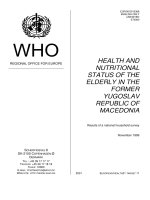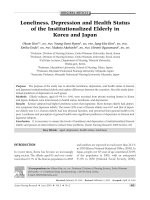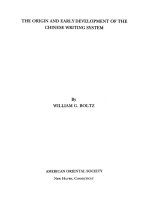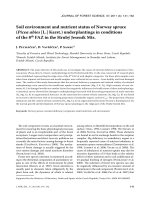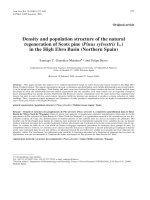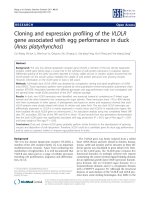Ecology and population status of the puku antelope (kobus vardonii LIVINGSTONE, 1857) in zambia
Bạn đang xem bản rút gọn của tài liệu. Xem và tải ngay bản đầy đủ của tài liệu tại đây (5.12 MB, 308 trang )
Ecology and Population Status of the Puku Antelope
(Kobus vardonii LIVINGSTONE, 1857) in Zambia
Dissertation
zur
Erlangung des Doktorgrades (Dr. rer. nat.)
der
Mathematisch-Naturwissenschaftlichen Fakultät
der
Rheinischen Friedrich-Wilhelms-Universität Bonn
vorgelegt von
Vera Rduch
aus Kleve
Bonn, September 2013
Angefertigt mit der Genehmigung der Mathematisch-Naturwissenschaftlichen Fakultät der
Rheinischen Friedrich-Wilhelms-Universität Bonn.
Dissertation for the degree of Doctor of Science (Dr. rer. nat.) in Zoology at the Rheinische
Friedrich-Wilhelms-Universität Bonn.
This thesis was compiled with the permission of the Faculty of Mathematics and Natural
Sciences of the Rheinische Friedrich-Wilhelms-Universität at Bonn.
1. Gutachter: Prof. Dr. Wolfgang Böhme
2. Gutachter: Prof. Dr. Horst Bleckmann
Tag der Promotion: 16. Dezember 2013
Erscheinungsjahr: 2014
Erklärung
Hiermit erkläre ich, dass ich diese Dissertation persönlich, selbstständig und unter
Offenlegung der erhaltenen Hilfen angefertigt habe und dass diese Arbeit noch nicht
anderweitig als Dissertation eingereicht wurde. Stellen der Arbeit, die anderen Werken in
Wortlaut oder Sinn entnommen wurden, sind unter Angabe der Quellen als Entlehnung
kenntlich gemacht.
Vera Rduch
Bonn, im September 2013
Declaration
I declare that the research described within this thesis is my own work and that this thesis is
my own composition. I certify that this thesis has never been submitted for any other degree
or professional qualification.
Vera Rduch
Bonn, September 2013
Diese Dissertation wurde innerhalb des ZamBio-Projektes des Zoologischen
Forschungsmuseum Alexander Koenig in Bonn in Zusammenarbeit mit der Zambian Wildlife
Authority durchgeführt.
This thesis was conducted within the ZamBio Project of the Zoologisches Forschungsmuseum
Alexander Koenig at Bonn in cooperation with the Zambian Wildlife Authority.
Ecology and population status of the puku antelope (Kobus vardonii) in Zambia
Contents
Abstract: “Ecology and population status of the puku antelope (Kobus vardonii LIVINGSTONE,
1857) in Zambia” ............................................................................................................... i
Zusammenfassung: “Ökologie und Populationsstatus der Puku Antilope (Kobus vardonii
LIVINGSTONE, 1857) in Sambia“ ........................................................................................... iii
Résumé: “L’écologie et l’état des populations de l’antilope puku (Kobus vardonii
LIVINGSTONE, 1857) en Zambie“ ........................................................................................... v
1
General Introduction .................................................................................. 1
1.1
1.2
1.3
2
General conception ............................................................................................................... 1
The puku – an outline ........................................................................................................... 5
The study region ................................................................................................................... 9
Population status, distribution patterns and habitat choice ...................... 16
2.1
2.2
2.2.1
2.2.2
2.2.3
2.2.4
2.3
2.3.1
2.3.2
2.3.3
2.3.4
2.3.5
2.3.6
2.4
2.4.1
2.4.2
2.4.3
2.4.4
2.4.5
2.4.6
2.4.7
2.4.8
3
Introduction ........................................................................................................................ 17
Material and Methods ........................................................................................................ 22
Data collection on the transect line ......................................................................................... 22
Location and short description of the transect lines ................................................................ 25
Setting camera-traps ................................................................................................................ 28
Data analyses ............................................................................................................................ 30
Results ................................................................................................................................ 36
Sightings on the transect lines .................................................................................................. 36
Habitat choice of antelopes ...................................................................................................... 40
Population estimates with DISTANCE ....................................................................................... 46
Results of the camera-trap survey............................................................................................ 53
Social organisation of the puku ................................................................................................ 55
Body condition of puku ............................................................................................................ 62
Discussion ........................................................................................................................... 64
General remarks to line transects and DISTANCE analyses ...................................................... 64
Distribution patterns of puku in the dry season ....................................................................... 66
The puku’s distribution in the late rainy season ...................................................................... 75
The development of the puku’s population in Kasanka NP...................................................... 75
The camera-trap survey ............................................................................................................ 77
Spatial overlap between puku and other antelopes ................................................................ 80
Looking inside the puku’s populations ..................................................................................... 85
Conclusions ............................................................................................................................... 92
Diet and dietary overlap of puku and other bovids .................................... 95
3.1
3.2
3.2.1
3.2.2
3.2.3
3.2.4
3.2.5
Introduction ........................................................................................................................ 96
Material & Methods ......................................................................................................... 100
Assessment and collection of grass species ........................................................................... 100
The reference collection of grasses ........................................................................................ 102
Collection of faecal samples of bovid species ........................................................................ 105
Analysis of faecal samples ...................................................................................................... 108
Data analyses .......................................................................................................................... 109
Ecology and population status of the puku antelope (Kobus vardonii) in Zambia
3.3
3.3.1
3.3.2
3.3.3
3.3.4
3.3.5
3.4
3.4.1
3.4.2
3.4.3
3.4.4
3.4.5
3.4.6
4
Results .............................................................................................................................. 111
Grass species in the study regions .......................................................................................... 111
Diet of puku and other bovid species ..................................................................................... 112
Food preferences in Kasanka NP ............................................................................................ 122
Measurements of diet breadth .............................................................................................. 127
Evaluation of dietary overlap ................................................................................................. 129
Discussion ......................................................................................................................... 138
General remarks about the methods ..................................................................................... 138
General classification of the puku’s diet ................................................................................ 139
Grasses in the puku’s diet....................................................................................................... 140
Variation in the puku’s diet .................................................................................................... 146
Dietary competition between bovid species .......................................................................... 150
Conclusions ............................................................................................................................. 153
Predation on the puku antelope ..............................................................156
4.1
4.2
4.2.1
4.2.2
4.2.3
4.3
4.3.1
4.3.2
4.4
4.4.1
4.4.2
4.4.3
4.4.4
5
Introduction ...................................................................................................................... 157
Methods ........................................................................................................................... 159
Searching for signs of carnivore species ................................................................................. 159
Analysis of the faeces of carnivores ....................................................................................... 161
Data analyses .......................................................................................................................... 163
Results .............................................................................................................................. 165
Faeces and other signs of predators ...................................................................................... 165
Determination of prey in the faecal samples ......................................................................... 169
Discussion ......................................................................................................................... 174
Assigning the faecal samples to predators ............................................................................. 174
Occurrence of predators in the study regions ........................................................................ 176
The puku as prey .................................................................................................................... 178
Conclusion: Top down regulation of puku.............................................................................. 187
Activity patterns of puku .........................................................................189
5.1
5.2
5.3
5.4
Introduction ...................................................................................................................... 190
Methods ........................................................................................................................... 192
Results .............................................................................................................................. 195
Discussion ......................................................................................................................... 205
6
General Synthesis ....................................................................................210
References
...............................................................................................................217
List of Figures ...............................................................................................................230
List of Tables ...............................................................................................................233
Abbreviations ...............................................................................................................235
Acknowledgment ...........................................................................................................236
Appendix
...............................................................................................................241
Ecology and population status of the puku antelope (Kobus vardonii) in Zambia
Abstract: “Ecology and population status of the puku
antelope (Kobus vardonii LIVINGSTONE, 1857) in Zambia”
by Vera Rduch
Dissertation for the degree of Doctor of Science (Dr. rer. nat.) in biology at the Rheinische
Friedrich-Wilhelms-Universität Bonn.
Explaining patterns of animal distribution and abundance is one major challenge of ecology.
The availability of habitats and food as well as predation determines the coexistence of
animal species. Thus, knowledge about abundance, distribution and resource partitioning is
of direct relevance to conservation and management of animal populations.
The puku antelope (Kobus vardonii LIVINGSTONE, 1857) was investigated in Zambia with a
focus on Kasanka National Park and on the Kafue Region, i.e. Kafue National Park and
surrounding Game Management Areas. Data about autecological and synecological aspects
of the puku’s ecology and population status were collected between 2009 and 2011 during
different seasons.
Road surveys along line transects were conducted at different times during the dry season.
Puku occurred in small to large groups. They preferred grassland where estimated
population densities were 36.15 puku/km² in Kasanka National Park and 14.66 puku/km² in
the Kafue Region, respectively. Puku were observed in lower numbers in intermediate
habitats and in miombo woodlands. Local population densities of the puku reached up to
almost 150 animals/km². Puku assembled especially on floodplains, grasslands or next to
rivers or lakes. For the survey period 2009/2010 in Kasanka National Park, a population size
of 5,038 (3,268-7,238) puku was calculated. This is an eightfold increase since the survey in
July 1994 and a result of the ongoing conservation work of Kasanka Trust Ltd. Assumed
higher juvenile survival might positively affect the numbers of puku in Kasanka National
Park, but may lead to differences in social organisation.
A reference collection of the epidermis of grasses was compiled for microhistological
analyses of plant fragments in bovid dung samples in order to assess their diet and dietary
overlap. Throughout all seasons and study regions, puku consumed almost exclusively
grasses. Particularly, they fed on Panicum spp., Brachiaria sp., Sporobolus spp.,
Hyparrhenia/Andropogon grasses and Eragrostris spp. in different amounts depending on
season, study region and sex. The puku’s dietary niche was broadest in the cool dry season
and narrowest in the late rainy season. In Kasanka National Park, the analysis of puku dung
from different sites revealed a high spatial variation in the puku’s diet which suggests an
opportunistic choice of grass species.
In Kasanka National Park, there was a slight spatial overlap with sitatunga (Tragelaphus
spekii). Between the puku and other bovids in Kasanka National Park, there was a slight
dietary overlap during the cool dry season, but virtually no dietary overlap during the hot dry
season. In the Kafue Region, puku and impala (Aepyceros melampus) occurred syntopicly.
They had similar distribution patterns over the transect lines, but however, impala were
encountered to a higher extent in woodlands and intermediate habitats. In the late rainy
season, due to an increasing amount of grasses in the impala’s diet, the dietary overlap
i
Ecology and population status of the puku antelope (Kobus vardonii) in Zambia
between the impala and the puku increased, while it was rather low in the cool dry season.
Thus, one reason for high population densities of the puku in the study regions might be a
generally low dietary competition, especially in the dry season.
To assess the impact of predation on puku populations, scats of predators were collected. In
Kasanka National Park, hair of the puku and the sitatunga was found to almost equal
amounts in the scats of Nile crocodile (Crocodylus niloticus), which probably is the most
important predator of the puku, while large terrestrial predators were generally rare. Whitetailed mongooses (Ichneumia albicauda) and African civets (Civettictis civetta) consumed
puku presumably by scavenging only. In the Kafue Region, the puku occurred in the scats of
lion (Panthera leo) and of spotted hyena (Crocuta crocuta) to considerable amounts, but for
none of them, the puku was the preferred prey. Instead, puku were consumed in accordance
to its availability. Predation pressure of large terrestrial predators appeared rather low in
Kasanka National Park and in consequence does not limit the population of puku. In the
Kafue region, predation was suggested to be higher and possibly regulates the puku’s
population to a greater extent.
However, considering the higher numbers of juveniles, male-groups and individuals in poor
body condition, bottom-up regulation via rainfall and food is very likely to act particularly on
the puku’s population in Kasanka National Park.
The activity patterns of the puku showed that it is not predominantly diurnal. While puku
grazed mainly at dawn, they rested during the day.
During this study, a lot of insight into the Zambian ecosystem could be gained, reaching from
grasses over antelopes to carnivores. New information is presented about population
densities and social organisation of the puku. For the first time in Zambia, the food plants of
the puku were investigated by microhistological analyses of dung and the circadian activity
patterns of the puku were assessed. Thus, besides confirming the few existing knowledge,
this study revealed new facts about the puku’s ecology and population status in Zambia.
keywords: puku, Kobus vardonii, Bovidae, Zambia, Africa, distance sampling, population
status, habitat choice, microhistological analyses, diet, predation, activity patterns
ii
Ecology and population status of the puku antelope (Kobus vardonii) in Zambia
Zusammenfassung: “Ökologie und Populationsstatus der
Puku Antilope (Kobus vardonii LIVINGSTONE, 1857) in Sambia“
von Vera Rduch
Dissertation zur Erlangung des Doktorgrades (Dr. rer. nat.) der MathematischNaturwissenschaftlichen Fakultät der Rheinischen Friedrich-Wilhelms-Universität Bonn
Eine der größten Herausforderungen der Ökologie ist es, Verbreitungsmuster und Abundanz
von Tieren zu erklären. Die Verfügbarkeit von Habitaten und Nahrung sowie der Feinddruck
bestimmen die Koexistenz von Tierarten. Kenntnis von Häufigkeit, Verbreitung und
Aufteilung der Ressourcen ist unabdingbar für den Schutz und das Management von
Populationen.
Die Puku Antilope (Kobus vardonii LIVINGSTONE, 1857) wurde in Sambia untersucht mit einem
Schwerpunkt auf dem Kasanka Nationalpark und der Kafue Region, d.h. dem Kafue
Nationalpark und angrenzenden sog. Game Management Areas. Daten über autökologische
und synökologische Aspekte der Ökologie sowie zum Populationsstatus des Pukus wurden
zwischen 2009 und 2011 zu verschiedenen Jahreszeiten gesammelt.
Datenerhebungen entlang von Linientransekten wurden zu verschieden Zeitpunkten in der
Trockenzeit durchgeführt. Pukus kamen in kleinen bis großen Gruppen vor. Sie bevorzugten
Grasland, wo die geschätzten Populationsdichten im Kasanka Nationalpark 36,15 Puku/km²
und in der Kafue Region 14,66 Puku/km² betrag. In geringeren Populationsdichten kamen
Pukus in intermediären Habitaten und auch im Miombo vor. Lokale Populationsdichten der
Pukus erreichten fast bis zu 150 Tiere/km². Im Allgemeinen kamen Pukus vor allem auf
Flussebenen, Grasland und in der Nähe von Flüssen und Seen vor. Für den
Untersuchungszeitraum 2009/2010 wurde eine Populationsgröße von 5038 (3268-7238)
Pukus für den Kasanka Nationalpark berechnet. Das ist ein achtfacher Anstieg seit einer
Untersuchung im Jahr 1994 und ein Ergebnis der kontinuierlichen Arbeit des Kasanka Trust
Ltd. Eine vermutlich geringe Sterblichkeit der Jungtiere beeinflusst positiv die Anzahl der
Pukus im Kasanka Nationalpark aber könnte auch der Grund für Unterschiede in deren
sozialen Organisation sein.
Eine Referenzsammlung zu Epidermisstrukturen von Gräsern wurde angelegt, um
mikrohistologische Analysen von Pflanzenfragmenten im Dung von Boviden durchzuführen
und so deren Nahrung und Nahrungsüberlappung zu ermitteln. Über alle Jahreszeiten und in
allen Untersuchungsgebieten konsumierten Pukus nahezu ausschließlich Gräser. Sie fraßen
vor allem Panicum spp., Brachiaria sp., Sporobolus spp., Hyparrhenia/Andropogon-Gräser
und Eragrostris spp. in unterschiedlichen Anteilen je nach Jahreszeit, Untersuchungsgebiet
und Geschlecht. Die Breite des Nahrungsspektrums war in der kühlen Trockenzeit am
weitesten und in der späten Regenzeit am engsten. Die Ergebnisse der Analyse von an
verschiedenen Stellen innerhalb des Kasanka Nationalparks gesammelten Dungproben ließ
eine opportunistische Wahl der Grasarten vermuten.
Im Kasanka Nationalpark gab es eine geringe räumliche Überlappung mit der Sitatunga
(Tragelaphus spekii). In Bezug auf die Nahrungspflanzen gab es zwischen Pukus und anderen
Boviden eine geringe Überlappung in der kühlen Trockenzeit und gar keine Überlappung in
iii
Ecology and population status of the puku antelope (Kobus vardonii) in Zambia
der heißen Trockenzeit im Kasanka Nationalpark. In der Kafue Region kamen Pukus und
Impalas (Aepyceros melampus) syntop vor. Sie verteilten sich sehr ähnlich über die
Transektlinien, allerding wurden die Impalas eher in Waldgebieten und intermediären
Habitaten angetroffen. Impala verändern ihren Nahrung mit den Jahreszeiten. In der späten
Regenzeit konsumierten Impalas mehr Gräser und die Überlappung der Nahrungsspektren
von Puku und Impala nahm zu dieser Zeit des Jahres zu. In der kühlen Trockenzeit gab es
eine geringe Überlappung. Somit erfährt das Puku vor allem in der Trockenzeit in beiden
Untersuchungsgebieten lediglich eine geringe Nahrungskonkurrenz, die mit ein Grund für die
hohen Populationsdichten der Pukus sein könnte.
Um den Einfluss von Fressfeinden auf die Populationen der Pukus zu ermitteln, wurden
Kotproben von Raubtieren gesammelt. Haare von Puku und Sitatunga wurden zu etwa
gleichen Anteilen in Kot von Nilkrokodilen (Crocodylus niloticus) gefunden. Das Krokodil ist
möglicherweise der wichtigste Feind der Pukus im Kasanka Nationalpark, wo größeren
Landraubtiere selten sind. Weißschwanzmanguste (Ichneumia albicauda) und Afrikanische
Zibetkatze (Civettictis civetta) fraßen Pukus, aber wahrscheinlich in Form von Aas. In der
Kafue Region konnte das Puku in beachtlichem Maß im Kot von Löwe (Panthera leo) und
Tüpfelhyäne (Crocuta crocuta) nachgewiesen werden. Allerdings bevorzugt keiner von
diesen Räubern das Puku; der Anteil in der Nahrung geht mit der Verfügbarkeit einher. Im
Kasanka Nationalpark schien der Prädationsdruck von großen Landraubtieren auf das Puku
eher gering und limitiert nicht die Population des Puku. In der Kafue Region hingegen wurde
eine größere Prädation auf das Puku angenommen, so dass die dortige Population hierdurch
in größerem Maß reguliert wird.
In Anbetracht der großen Anzahl von Jungtieren, Männchengruppen und Individuen mit
schlechter Körperverfassung im Kasanka Nationalpark scheint es wahrscheinlich, dass
bottom-up Regulation in Form von Regenfällen und Nahrung die Populationen der Pukus vor
allem dort beeinflusst.
Beobachtungen zu den Aktivitätsmustern der Pukus ergaben, dass es vorwiegend nicht
tagaktiv ist. Pukus grasten vor allem in der Dämmerung. Am Tag ruhten sie.
Während dieser Studie konnten viele Einsichten in das Ökosystem in Sambia gewonnen
werden, die von Gräsern über die Antilopen bis hin zu den Raubtieren reichen. Neue
Informationen zu Populationsdichten und sozialen Organisation der Puku werden
vorgestellt. Zum ersten Mal wurden für Sambia die Nahrungspflanzen der Pukus über
mikrohistologische Untersuchungen von Kot ermittelt sowie die Aktivitätsmuster über Tag
und Nacht. Somit, neben der Bestätigung des bereits Bekannten, konnte diese Studie dazu
betragen, neue Erkenntnisse zu Ökologie und Populationsstatus der Puku in Sambia zu
gewinnen.
Schlagwörter: Puku, Kobus vardonii, Bovidae, Afrika, distance sampling, Populationsstatus,
Habitatwahl, mikrohistologische Analysen, Nahrung, Prädation, Aktivitätsmuster
iv
Ecology and population status of the puku antelope (Kobus vardonii) in Zambia
Résumé: “L’écologie et l’état des populations de l’antilope
puku (Kobus vardonii LIVINGSTONE, 1857) en Zambie“
rédigé par Vera Rduch
Thèse de Doctorat en biologie à la Rheinische Friedrich-Wilhelms-Universität Bonn
Expliquer la distribution et l’abondance des populations d’animaux est l’un des défis de
l’écologie. La disponibilité des habitats, de la nourriture et la prédation influent sur la
coexistence des espèces animales. Connaître l’abondance, la distribution et la répartition des
ressources est essentiel pour la conservation et la gestion des populations.
Les populations de pukus (Kobus vardonii LIVINGSTONE, 1857) (ou Cob de Vardon) ont été
étudiées en Zambie, principalement dans le Parc National de Kasanka et dans la « région
Kafue » c’est à dire dans le Parc National du Kafue ainsi que dans ses environs (Game
Management Areas). Le but de l’étude a été de rechercher des aspects autécologiques et
synécologiques affectant le mode de vie et les populations des pukus. La collection des
données a été faite de 2009 à 2011, à des saisons différentes.
Des transects en lignes ont été effectués le long des chemins pendant plusieurs périodes de
la saison sèche. Les pukus se rassemblaient dans des groupes de petite à grande taille. Ils
préféraient vivre en prairies où la densité de leur population avoisinait les 36,15 pukus/km²
au Parc National de Kasanka ; elle était de 14,66 pukus/km² en Kafue région. Le nombre des
pukus était plus réduit dans des habitats intermédiaires et dans le miombo. La population a
pu atteindre localement jusqu’à 150 pukus/km², principalement dans les plaines inondables,
en prairie et à proximité des rivières et des lacs. Pour la période couverte par l’étude de
2009 à 2010 la population totale des pukus a été évaluée à 5038 (3268-7238) animaux. C’està-dire huit fois plus qu’en Juillet 1994 ; ce qui fut certainement le résultat positif de la
politique de conservation menée par Kasanka Trust Ltd. Le taux de survie des juvéniles
semblait plus élevé au Parc National de Kasanka favorisant l’accroissement de la population ;
il faut noter que cela semblait modifier aussi l’organisation sociale.
Une collection de référence de la structure des épidermes de graminées a été créé pour
pouvoir faire des analyses microhistologiques des fragments de plantes contenus dans les
excréments de Bovidés et mieux connaître leur alimentation et les interférences
alimentaires. Partout et toujours, le régime alimentaire des pukus était constitué presque
exclusivement de graminées : surtout Panicum spp., Brachiaria sp., Sporobolus spp.,
Hyparrhenia/Andropogon et Eragrostris spp. en quantité différente selon la période de
l’année, la région et le sexe. La variété du régime alimentaire du puku était plus étendue
pendant la saison sèche et froide et plus ciblée à la fin de la saison des pluies. L’analyse de la
nourriture des pukus à des endroits différents dans la Parc National de Kasanka a révélé une
variation importante dans la nourriture et suggéré un choix opportuniste de graminées par
les pukus en fonction des circonstances.
Dans le Parc National de Kasanka les pukus et les sitatungas (Tragelaphus spekii)
cohabitaient de temps en temps. La compétition entre les pukus et les autres Bovidés sur le
plan alimentaire était minimale pendant la saison sèche et froide et n’existait pas en saison
sèche et chaude. En région Kafue les pukus et les impalas (Aepyceros melampus) vivaient de
façon syntopique : ils avaient une distribution comparable au long des transects, mais les
v
Ecology and population status of the puku antelope (Kobus vardonii) in Zambia
impalas étaient plus fréquents dans des habitats intermédiaires et dans le miombo. A la fin
de la saison des pluies l’impala changeait son régime alimentaire, la proportion de graminées
était plus élevée, et la concurrence alimentaire avec les pukus était alors plus sensible. En
saison sèche et froide cette concurrence était très atténuée ce qui pourrait expliquer le
nombre des pukus dans ces régions.
Pour étudier l’impact de la prédation sur les populations des pukus, les excréments des
carnivores ont été analysés. Les pukus et les sitatungas étaient consommés en quantité
équivalente par le crocodile du Nile (Crocodylus niloticus) qui est probablement le prédateur
le plus important de pukus dans le Parc National de Kasanka où les grands carnivores
terrestres sont rares. La mangouste à queue blanche (Ichneumia albicauda) et la civette
africaine (Civettictis civetta) avaient consommé du puku, probablement à l’état de cadavre,
en charognard. En région Kafue, un nombre considérable de pukus a été la proie des lions
(Panthera leo) et des hyènes tachetées (Crocuta crocuta). Cependant aucun des deux
prédateurs ne recherchait particulièrement le puku mais ils le consommaient simplement
parce qu’il est très commun. La pression de la prédation des grands carnivores terrestres
était faible au Kasanka et elle n’influe pas sur la population des pukus. Au contraire en région
Kafue, les prédateurs semblent être un vecteur de régulation de la population.
En particulier au Parc National de Kasanka, si l’on considère la proportion plus élevée de
juvéniles, de groupes de mâles, ou d’individus physiquement affaiblis, les populations de
pukus paraissent davantage tributaires des précipitations et donc de la nourriture
disponible.
L’éthologie du puku a révélé que l’antilope n’était habituellement pas active pendant la
journée mais qu’elle s’alimentait surtout au crépuscule. Les journées étaient consacrées au
repos.
L’étude a permis de collecter un grand nombre de données sur l’écosystème en Zambie, à
partir des graminées mangées par les antilopes jusqu’aux grands carnivores. De nouvelles
informations ont été rassemblées sur la densité des populations et l’organisation sociale.
Pour la première fois en Zambie, les plantes dont se nourrissent les pukus ont été identifiées
grâce à une analyse microhistologique des excréments, et l’observation de comportements
des pukus a été faite de jour comme de nuit. Cette étude a mis en évidence le peu de
connaissance sur les pukus et elle a apporté des informations nouvelles sur l’écologie et
l’état des populations de pukus en Zambie.
mots-clés: puku, Kobus vardonii, Bovidae, Afrique, distance sampling, état des populations,
le choix de l’habitat, analyses microhistologiques, nourriture, predation, comportement
vi
Ecology and population status of the puku antelope (Kobus vardonii) in Zambia
“Here I lay, looking at the graceful forms and motions of beautiful pokus, leches and
other antelopes, …”
DAVID LIVINGSTONE
Ecology and population status of the puku antelope (Kobus vardonii) in Zambia
Ecology and population status of the puku antelope (Kobus vardonii) in Zambia
Chapter 1: General Introduction
1 General Introduction
1.1 General conception
This PhD-thesis was conducted in the context of the Zambian Biodiversity Project
(ZamBio Project) of the Zoologisches Forschungsmuseum Alexander Koenig, the Zoological
Research Museum Alexander Koenig, (ZFMK) in Bonn, Germany. Independent from the
sections within the ZFMK, but encompassing different research approaches and subjects, the
ZamBio Project aims to investigate the biodiversity of Zambia. During previous research
within the ZamBio Project, the diversity and the distribution of African reptiles with a focus
on agamid lizards (WAGNER 2010) as well as the ecology and the population status of cats
namely the serval (Leptailurus serval) (THIEL 2011) and the leopard (Panthera pardus) (RAY
2011) were examined. The scientific results gained shall help to improve natural
conservation measures in Zambia to protect its unique wildlife.
My diploma thesis about habitat preferences and distribution of the puku (Kobus
vardonii) in Luambe National Park (RDUCH 2008) already contributed to the ZamBio Project.
During that research I concluded that there was need for further research on the puku. Thus,
I decided to investigate the puku antelope with a focus on Zambia during this PhD-thesis in
order to help improving to natural conservation measures.
In Zambia, the territoriality of male puku has attracted much attention and scrutiny of
previous researchers. In Tanzania, where most of the research data comes from, the puku
was investigated focussing on population assessment and habitat use. While the research in
Tanzania was conducted mainly in Kilombero Valley, most of the information on Zambia’s
puku comes from South Luangwa NP. Only a few studies come from areas other than these
two study regions or investigated beyond these two topics. Recent studies on the puku were
not undertaken in Zambia. However, knowledge about numbers and abundance is very
important for conservation (SHORROCKS et al. 2008, OGUTU et al. 2006), but it is just as
important to know how these numbers emerge. Following this the general question is: What
affects the abundance and distribution of the puku in selected areas of Zambia?
1
Ecology and population status of the puku antelope (Kobus vardonii) in Zambia
Chapter 1: General Introduction
Three factors determine distribution patterns: the dispersal capacities of the species,
the spatial distribution of favourable environmental conditions and the biotic environment
constituted by the species’ competitors, predators and pathogens, together with the
availability and dynamic of resources (SOBÉRON 2007). This indicates a relationship between
distributional areas and niches (SOBÉRON 2007). One major challenge of ecology is to explain
those patterns of animal (and plant) distribution and abundance (HUNTER & PRICE 1992). To
explain abundance and distribution of the puku in Zambia, the investigation of the puku’s
ecological niche, its role in the Zambian ecosystem is important and thus the common theme
of this study.
The term “niche” used here conforms to ELTON’s definition of the ecological niche
which means “the animal’s place in its community, its relation to food and enemies, and to
some extent to other factors” (ELTON 1927). The ecological niche is one of the most
important concepts in ecology (GODSOE 2010). The functional concept niche of ELTON
(WHITTAKER et al. 1973) is defined by biotic interactions and resource-consumer dynamics
which both can be measured (SOBERÓN 2007). In contrast to variables, applicable for the
Grinnelian niche concept, resources can be consumed and populations may impact and
compete for them (SOBERÓN 2007). It is generally accepted that environmental variables and
resources can interact and hence that the distinction is rather artificial (SOBERÓN 2007).
Competition affects realised niches (WHITTAKER et al. 1973) and it is the dominant process
that affects ungulates (SINCLAIR 1979a). It is a result of shortage or, vice versa, without
shortage there is no competition (WHITE 1978). The question ‘how many’ survive is answered
by the factor, e.g. food, the competition decides ‘which ones’ survive (WHITE 1978).
Interspecific competition results in selection pressures that can lead to resource partitioning
(WALTER 1991). Regardless of the origins of the differences, resource partitioning are
differences in resource use between species (WALTER 1991). Thus, among coexisting species,
differences in resource use can be observed (SCHOENER 1974). On food as example for
resource SCHOENER (1974) discussed that it can be consumed in different habitats, at a
different time of the day or of the year, at different vertical scales (in trees) or that different
sizes or parts of the food source are consumed.
Antelopes partitioned the African ecosystem into many small segments (ESTES 1991).
The African continent provides a lot of ecological opportunities for the bovids to exploit with
regard to habitats and food (ESTES 1991). Together with predation, habitat and food
determine evolution, adaptation and thus coexistence of bovid species (SINCLAIR 1983). This
speciation processes in African bovids were promoted by climatic changes during the
2
Ecology and population status of the puku antelope (Kobus vardonii) in Zambia
Chapter 1: General Introduction
Pliocene-Pleistocene, where the major radiation of bovids took place (SINCLAIR 1983, ESTES
1991). These climate changes caused expansion and contraction of the equatorial rain forest
or the arid regions, respectively, in pluvial or interpluvial periods (SINCLAIR 1983, ESTES 1991).
Knowledge of competition or resource partitioning is fundamental to understanding not only
evolution but also sympatric occurrence of bovid species nowadays. The knowledge of
resource partitioning is of direct relevance to conservation and management of the
(protected) area (JARMAN & SINCLAIR 1979). The understanding of the ecological niche of the
organisms is of interest for natural conservation issues, too. Specialists characterised by a
narrow niche experience a higher risk of extinction relative to generalist species (DEVICTOR et
al. 2010).
Data sets of Eltonian niches have to be measured in field studies (SOBÉRON 2007) and
this is what was done for this study. The basis of this study is data about the population
status and the distribution of the puku. These data is complemented by data about
autecological and synecological aspects of the puku’s ecology. Thus, the study is structured
into sections in order to deal with different questions:
What are the population densities of the puku in the study regions? How are puku
distributed within the study areas? Are there any other bovid species that have similar
distribution patterns? It is suggested that in grassland areas, puku occur at higher
densities than in woodlands. They might be more abundant in areas near water sources
where they assemble especially with the ongoing dry season. If impala occur
sympatrically with puku, impala should occur in woodlands at higher densities than in
open grasslands.
What are common group sizes and group compositions of the puku? General traits of the
social organisation are suggested to be similar in the study regions: small to medium
group sizes, groups of females with young and single males occur and the sex ratio is
biased towards the females.
Puku are suggested to feed to a high extent on monocotyl plants. But which plants are
the main food sources? As the two study regions lie in the miombo ecoregion the actual
food plants might be similar. Sympatric occurrence with other antelopes might be
enabled by differences in the diets.
3
Ecology and population status of the puku antelope (Kobus vardonii) in Zambia
Chapter 1: General Introduction
Puku are supposed to be prey of different carnivore species. But which predators do
actually occur in the study regions and what about it the amount of the puku in their
diet?
What activity patterns do puku show? They are suggested to have specific times of day
and night where they show feeding and resting behaviours. The general patterns of
activities are alike between study areas, but might differ between the puku and
antelopes that occur the same habitats or areas.
The puku is classified as “near threatened” by the IUCN Red List (IUCN SSC ANTELOPE
SPECIALIST GROUP 2008). This often raises the question why one should invest into research in
that case. The answer: Even if the puku is not endangered, research can help to reveal what
conditions are most suitable for them. Future changes in ecology can be detected.
Awareness of the factors that might affect the abundance and distribution of animals can
useful to point out potential threats and hence provide the background for purposeful
conservation measures.
Data collection was carried out within three separate field trips to Zambia. I focussed
on the puku population in Kasanka National Park in northern Central Zambia, where I visited
on three different seasons of the year. These data were complemented by data collected
from Kafue National Park and adjacent Game Management Areas (GMA).
Out of necessity, I virtually conducted this research project without an extensive
funding. All methods applied during this study and presented here required a relatively low
budget. Undeniably, they still require certain amount of equipment. This was partially
offered by kind sponsors or provided by the facilities of the ZFMK. Nevertheless, the results
gained provide detailed and reliable information on different aspects of the ecosystem as
required for good conservation practice.
4
Ecology and population status of the puku antelope (Kobus vardonii) in Zambia
Chapter 1: General Introduction
1.2 The puku – an outline
The puku (Kobus vardonii LIVINGSTONE, 1957) is a medium sized antelope (SKINNER &
CHIMIMBA 2005). Its shoulder height is about 77 to 94 cm with the males being taller than
females (HUFFMAN 2011, STUART & STUART 2006). The tail is not bushy and has a length of 28 to
32 cm (SKINNER & CHIMIMBA 2005, KINGDON 2007). Weight is about 77 kg for males and 66 kg
for females (HUFFMAN 2011). Beside these differences in physical dimensions, puku are
sexually dimorphic as only the males carry lyre-shaped, stout horns (Figure 1-1) (SKINNER &
CHIMIMBA 2005, HUFFMAN 2011). These horns reach an average length of 45 cm and are
strongly ridged for about two third of their length, smoothing towards the tips; the longest
horns were recorded in Luangwa Valley, Zambia, measuring 56.2 cm (STUART & STUART 2006,
SKINNER & CHIMIMBA 2005). The pelage is about 32 mm long and somewhat coarse (SKINNER &
CHIMIMBA 2005, HUFFMAN 2011). The upperparts as well as the tail are golden-yellow, and
underparts, throat, sides of the muzzle and hair around the eyes are off-white as are the
insides of the limbs and the inside of the ears (Figure 1-1) (STUART & STUART 2006, SKINNER &
CHIMIMBA 2005, HUFFMAN 2011). Active preorbital glands cause a small tuft of black hair and
these glands with their greasy secretion are responsible for the dark neckpatch of territorial
males (HUFFMAN 2011, ROSSER 1990).
A
B
Figure 1-1: Puku (Kobus vardonii) in Kasanka National Park, Zambia: a male (A) and a female with a calf (B).
The puku’s distribution (Figure 1-2) is widely fragmented across Southern Central
Africa along the margins of lakes, swamps, rivers and floodplains with Zambia being the
centre of occurrence (STUART & STUART 2006, KINGDON 1982, MILLS & HES 1999). Otherwise,
puku are common in Tanzania (BONNINGTON et al. 2010) but also occur in Angola, east
Namibia, northeast Botswana, southeast DR of Congo, and north and west Malawi (HUFFMAN
2011). Total numbers of the puku are estimated to be 76,000 to 130,000 animals (HUFFMAN
5
Ecology and population status of the puku antelope (Kobus vardonii) in Zambia
Chapter 1: General Introduction
2011). 75% of all puku live in the unprotected Kilombero Valley in Tanzania, the majority of
the remaining puku lives in Zambia (HUFFMAN 2011) (see also Chapter 2). Puku are
threatened by anthropogenic factors: above all habitat fragmentation (IUCN SSC ANTELOPE
SPECIALIST GROUP 2008), habitat loss, illegal hunting, and competition with cattle herds
(HUFFMAN 2011). The puku is classified as “Near Threatened” by the IUCN Red List (IUCN SSC
ANTELOPE SPECIALIST GROUP 2008).
Figure 1-2: Geographic range of the puku (Kobus vardonii) (modified from JENKINS 2013).
The puku was first described by DAVID LIVINGSTONE in his diaries “Missionary Travels and
Researches in South Afrika”, published 1857 in London. He writes: “I propose to name this
new species ‘Antelope Vardonii’, after the African traveller, Major Vardon.“ (LIVINGSTONE
1857). Thus, LIVINGSTONE latinised the name of Major Vardon. I will use his spelling vardonii
for the epithet of species in this thesis – although there is another spelling (vardoni) to be
found in literature. The common name is derived from “phuku”, the antelope’s name in the
Setswana language. In Zambia, the puku is called “Nsebula” by the Bemba people or
“Nseula” by the Nyanja people (ANSELL 1978). Concerning the plural ending of the puku, two
spellings exist, which are “puku” (confer e.g. WILSON & MITTERMEIER 2011, IUCN SSC ANTELOPE
SPECIALIST GROUP 2008, DIPOTSO & SKARPE 2006, SKINNER & CHIMIMBA 2005, JENKINS et al. 2003
CORTI et al. 2002, GOLDPINK et al. 1998, CHILD &
VON
RICHTER 1969) and “pukus” (confer e.g.
KINDGON & HOFFMANN 2013a). In this thesis I will use the plural form “puku”. This is similar for
other antelopes as impala or sitatunga.
The puku is a member of the order Artiodactyla if following the established systematic
also used in WILSON & MITTERMEIER (2011); other authors include this order in the
Cetartiodactyla (PRICE et al. 2005). However, the order is the puku further belongs to the
family Bovidae, the hollow-horned ruminants (HUFFMAN 2011). Within the tribe of the
Reduncini, the puku is classified nowadays as a member of the genus Kobus. Two subspecies,
6
Ecology and population status of the puku antelope (Kobus vardonii) in Zambia
Chapter 1: General Introduction
K.v.vardonii and K.v.senganus, are mentioned by ANSELL (1960a, 1978). They are considered
invalid by HUFFMAN (2011a), but recent findings suggest that puku in Tanzania differ from
those in Zambia (JENKINS 2013). The kob antelope (Kobus kob), is the puku’s next relative
(BIRUNGI & ARCTANDER 2001). The relation between those two can be considered somewhere
between the level of subspecies and full species, what ESTES (1991) calls a superspecies. The
puku has heavier proportions, a coarser coat and the horns are shorter, less lyrate shaped
than the kob (KINGDON 2007). Living in allopatry, they replace each other ecologically: kobs
occur in the northern savannahs and puku in the southern ones (BIRUNGI & ARCTANDER 2001,
SHORROCKS 2007, ESTES 1991). Basing their research on mitochondrial cytochrome b data,
BIRUNGI & ARCTANDER (2001) revealed that the puku is a highly differentiated population of
the kob, separated around 150.000 years ago, which would justify the designation of the
puku as a distinct species. Still, the puku is treated as an own species by recent literature or
the IUCN (e.g. SKINNER & CHIMIMBA 2005, STUART & STUART 2006, IUCN SSC ANTELOPE SPECIALIST
GROUP 2008, HUFFMAN 2011). The genus Kobus comprises further the waterbuck Kobus
ellipsiprymnus, the lechwe (Kobus leche) and the Nile lechwe (Kobus megaceros). According
to mitochondrial cytochrome b data, the waterbuck (Kobus ellipsiprymnus) is considered to
be the sister group of kob and puku (BIRUNGI & ARCTANDER 2001).
Puku are gregarious occurring mostly in small groups (SKINNER & CHIMIMBA 2005). Larger
groups up to 100 individuals can be found, though (DE VOS & DOWSETT 1964). The groups are
rather unstable as the individuals move freely among the groups (DE VOS & DOWSETT 1964).
Puku are grazers (GAGNON & CHEW 2000). They are said to be highly specialised in their
habitat requirements (DIPOTSO & SKARPE 2006): They inhabit floodplains and adjacent wellwatered grasslands, therefore they can be found along rivers, swamps or lakes and on
dambos (HUFFMAN 2011, KINGDON 2007, SKINNER & CHIMIMBA 2005).
Adult territorial males hold territories from a few days to several months (SKINNER &
CHIMIMBA 2005). The territories are mostly in open habitats; overlap between territories is
possible (DE VOS 1965). ROSSER (1992) differentiates between clumped grouped territories
located in open floodplain areas that are small (0.05 km²) and the more dispersed single
territories in woodland areas that are larger (0.14 km²). These territory types represent two
alternative strategies of male mate access (ROSSER 1992). Grouped territories attract more
females, intermale competition is higher and chances of male mate access can be very high.
Single territories are more likely to be kept by the owning male, but the opportunity for
mating is generally reduced (ROSSER 1992). Female puku move across one to four territories
within 12 hours (BALMFORD et al. 1992). When in oestrus, females can mate with up to 3
7
